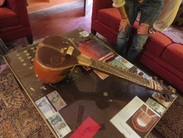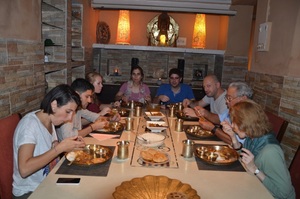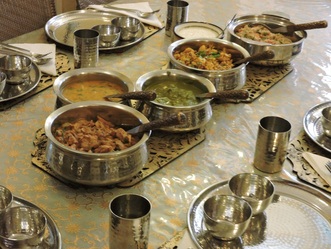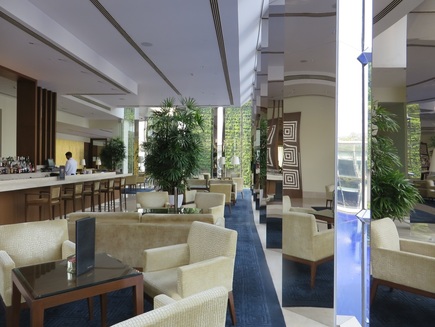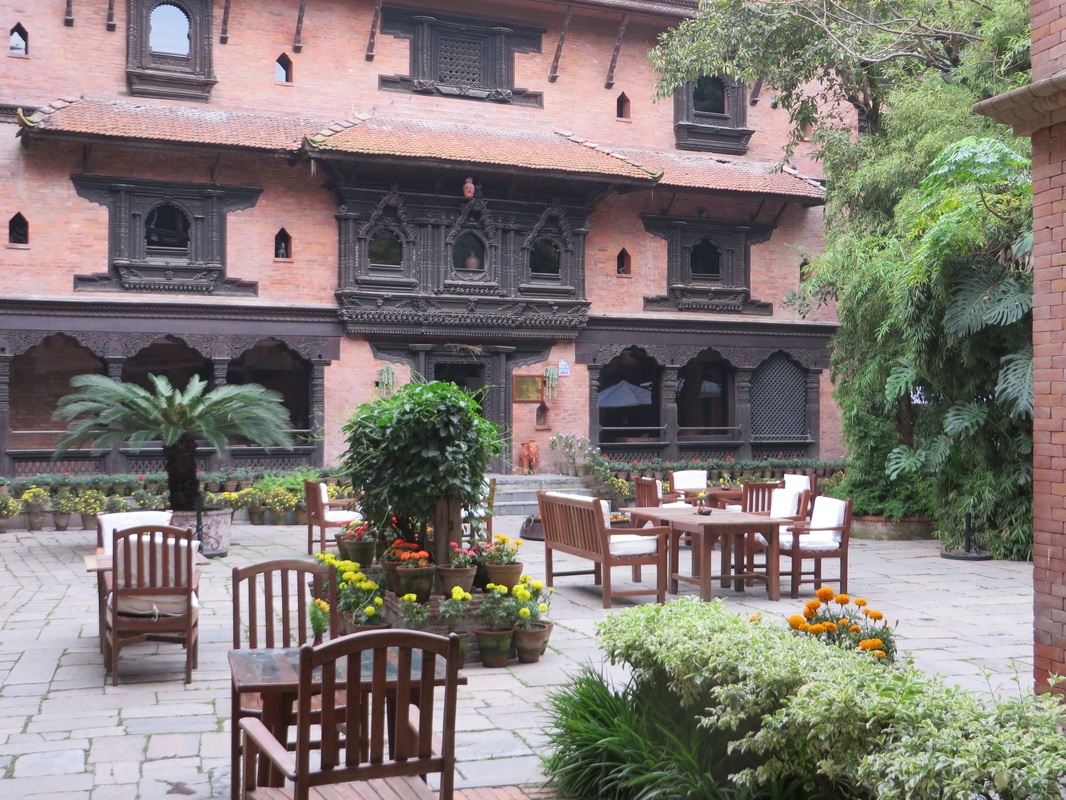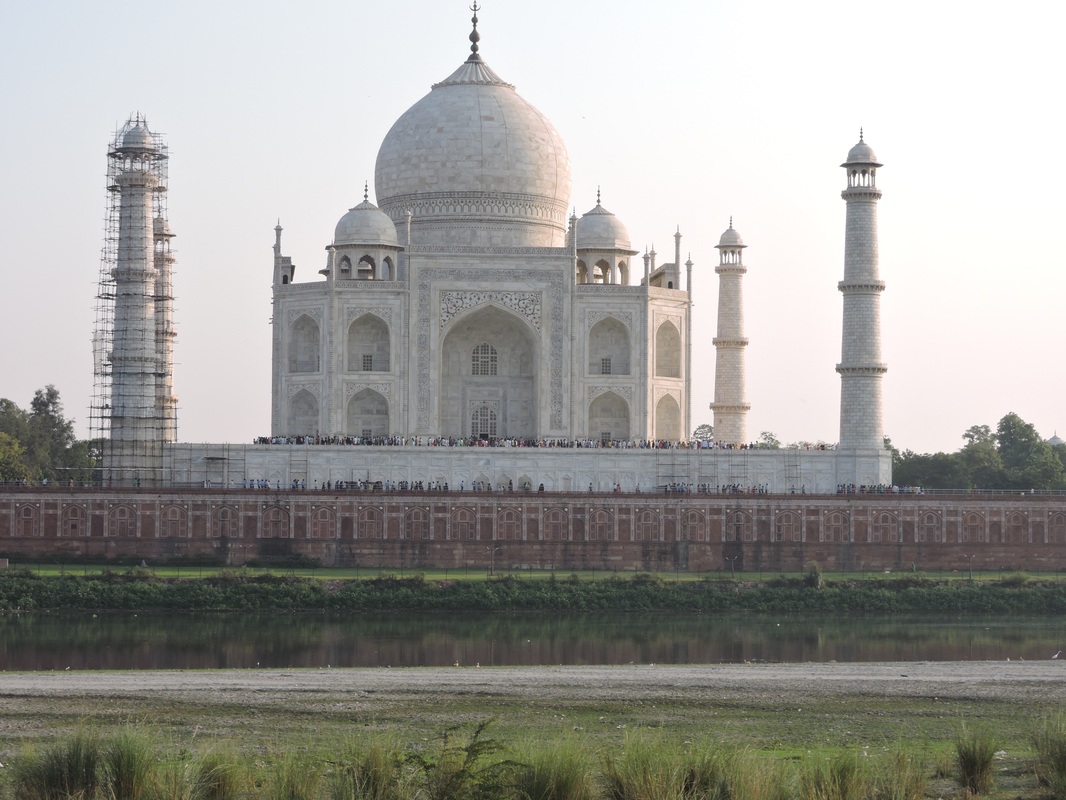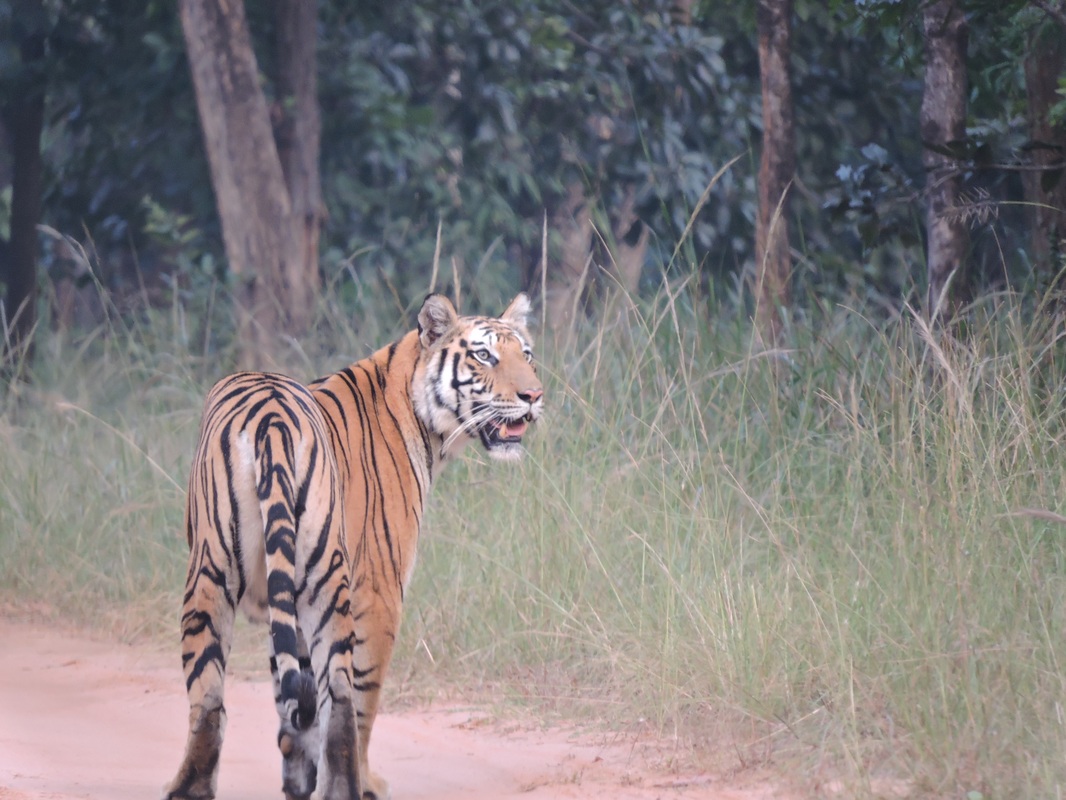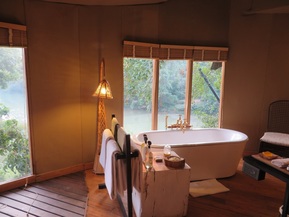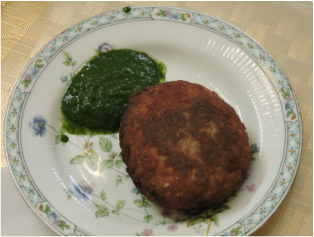Dhruv’s family has lived in Old Delhi for five generations, and he knows his way around the spice market. He is also sensitive to the potential digestive issues that visitors could encounter by sampling street food unsupervised. Surrounded by fruits, vegetables, tea and spices, we enjoyed the morning sights and scents, observed by monkeys perched on the overhead electric wires and joined by neighborhood cows, wandering genially through the narrow streets. Our first snack spot was a large vat of foamy milk dessert, a local specialty popular during the Dewali Festival. The young man in charge of the vat gave us each a small serving, and we enjoyed the ethereal taste and texture, a bit like eating soft cotton candy without the cloying over sweetness.
The buffet continued to beckon, and we moved on to the flaky croissants and other European pastries with a stunning array of marmalades from which to choose: bitter orange and whiskey; date and prune; orange, apricot and brandy. (I tasted them all! No disappointments.) We also enjoyed pressed pineapple slices with fresh basil and carrot, beet and ginger juice. I have only scratched the surface of this astounding buffet in this brief summary. Picture everything that any traveler might want for breakfast, from Marmite for the intrepid British adventurer to bacon and eggs for the Americans.
With the towering Himalayas not far distant, our Buddha Airlines plane landed at the humble and unpretentious Katmandu airport. A large sign on the terminal read, “Welcome to Nepal, Birthplace of the Buddha.” No fancy neon signs are necessary for a country that can claim an individual who has exerted such a profoundly positive influence on art, architecture, philosophy and personal conduct over so many people for so many centuries. Nepal was still recovering from the recent earthquake, and sadly several beautiful and ancient temples and stupas were severely damaged, but the people of Nepal were busy making repairs and offering generous hospitality to their visitors. We stayed at Dwarika’s Hotel, where scarves of gold colored cloth were placed around our necks at our arrival as a sign of welcome. Dwarika’s is an exquisite and unique place that captures the beauty of ancient Nepal in a very personal way.
The hotel was founded about three generations ago by a man named Dwarika who originally had no intention of going into the hospitality business. As a young man, he noticed that the beautiful hand carved wooden window surrounds, so striking an element in traditional Nepalese architecture, were being removed and used for firewood. Horrified, Dwarika embarked on a one-man mission to save as many pieces of traditional hand carved decorative woodwork as possible. His collection eventually included wooden chests, tables and other pieces of furniture as well as the window decorations. Ultimately, he found himself in possession of so many of these wooden treasures that he decided to open a sort of museum hotel so others could also enjoy these lovely pieces of classical Nepalese art.
When we arrived at Dwarika’s Hotel, we were greeted by Dwarika’s grandson, a poised and articulate young man who now runs the hotel. He explained the hotel’s history and emphasized Dwarika’s current mission to revive and preserve indigenous Nepalese arts and crafts while supporting a zero-waste lifestyle. This philosophy also entails providing guests with fresh and healthy Nepalese food grown in the hotel’s own organic farm. We were deeply grateful to be the recipients of these riches, both artistic and culinary. The hotel itself is tasteful and understated in its beauty. The two-story red brick structure is surrounded by lovely gardens and waterfalls, and the windows are graced with the carved wooden decorations rescued by Dwarika himself so many years ago. The rooms are unpretentious, comfortable and furnished with antique carved wooden furniture and traditional Nepalese textiles. We felt that we had been invited to stay in the home of some wise and subtle person who understood the beauty of simplicity and the timeless value of art.
The food at Dwarika’s was as elegant as the furnishings. I loved the ethereal house made yogurt with herbal honey at breakfast, and at dinner time, we experienced a nine-course Krishnarpan dinner featuring traditional Nepalese cuisine. The menu, printed on Nepalese hand-made paper, explained that, “Krishnarpan, which literally means offering to Lord Krishna, takes you on a journey through Nepal’s diverse culinary cultures. Celebrating Nepal’s social, cultural and geographic diversity, each dish is inspired by a particular community or region of Nepal.” I ate the vegetarian version of this menu and found it exquisitely delicious. I will share the non-vegetarian version, which Wayne ate. Note that as in traditional Indian food, beef is not included in a Nepalese meal, as cows are never slaughtered in Hindu culture because of the affection and spiritual reverence for these animals in the Hindu religion.
While the menu refers to this special Krishnarpan Dinner as a nine-course meal, the list of foods included seems to far exceed nine courses. Here is what Wayne ate: assortments of hors d’oeuvres served during religious ceremonies, roasted mushrooms, deep-fried soft bread, sautéed organic spinach with Nepalese spices, marinated pan-fried river fish with Nepalese rice risotto, bottle gourd stuffed with cottage cheese and vegetable mousse, Nepalese rice crepes with chicken filling, momos (traditional Nepalese minced meat dumplings served with chutney,) mixed vegetable soup, steamed organic rice, organic lentils flash fried with Himalayan herbs, traditional Nepalese chicken curry cooked with aromatic herbs and spices, sweet gourd and soybean curry cooked in thick gravy, stir fried eggplant, stir-fried potato and mini-gourd with Nepalese spices, radish pickles, home-made plum pickles, fresh yogurt flavored with cinnamon and sweetened with honey, fresh fruits, semolina pudding, tea or coffee. As you can imagine, this is a meal we will not soon forget.
In Agra, we stayed in another Oberoi hotel, the Oberoi Amarvilas, where every room has a view of the Taj Mahal. Fortunately, we were able to visit this magnificent memorial to the late wife of Emperor Shah Jahan close up on two other occasions, at dawn and at midmorning. The light changes, and the carvings on the white stone take on a different aspect at various times of day. The steady stream of respectful visitors from all over India and places beyond become part of the atmosphere, especially the Indian women in their best brightly colored saris. The contrast between the intense red, blue and yellow of the silk garments made the glittering white marble seem even more intense.
In the evening, surrounded by flowering gardens and cooling fountains, we experienced an exquisite Thali dinner prepared by the chefs at the Amarvilas. A Thali dinner is the Indian version of a tasting menu in which a variety of very small dishes are served, adding up to a complete meal. In the western version of a tasting menu, the small dishes are served chronologically as separate courses, and the meal can last for two or three hours with pauses between the courses. A Thali dinner is served all at once on a large round tray on which the individual dishes are arranged around a large pile of rice in the middle. Breads, condiments and dessert are always included in a Thali dinner. Wayne and I had eaten Thali dinners on many occasions in California, where large communities of Indian immigrants have come to work in the high tech industries, especially in Silicon Valley and the San Diego area, spawning a large number of good Indian restaurants. Although we have always thought that the Indian food in California is excellent, the Thali dinner at the Amarvilas was on an utterly different and higher gourmet plane than any Thali dinner we had ever enjoyed before.
Wayne chose the meat and seafood Thali which included prawns, fish, chicken and lamb. I chose the vegetarian selection. Our meal, served as a sort of hybrid between the traditional Indian Thali and the western tasting menu, was organized into four sections: Appetizers, (vegetarian or meat selections,) Soup, Main Course and Dessert. Each course, except the soup, had its own round tray with several small individual dishes. My appetizer selection included, spinach and sesame kebobs filled with apricot, triple layered cottage cheese kebobs with saffron, pan fried kidney bean kebob with onion yogurt, and crisp fried mushroom kebobs with cheese, all astoundingly creative and flavorful preparations. My soup selection was a delicious vegetarian version of the traditional Indian Mulligatwany Soup with lentils and coconut. The main course selections were stunning in their culinary expertise, but unfortunately I got so full that I could not enjoy them as I should have, one of the perils of the multi-course dinner. At least I was able to taste a little of the cottage cheese filled potatoes in pomegranate curry, smoked, crushed eggplant with onions and tomatoes, bottle gourd and prune dumplings in tomato curry, cottage cheese braised with lotus seeds, roasted garlic and winter greens, and black lentils cooked with garlic. Among the elegant desserts was Petha, the candied pumpkin dessert, a specialty of Agra. We congratulate the chefs at the Amarvilas for the innovation and meticulous attention to detail that went into creating this fresh, healthy and truly remarkable meal.
If you wish to create for yourself and your friends a peek through this beautiful window, you might choose to produce our Indian Chai Party in the World of Tea Parties section of our website, www.myteaplanner.com. The menu includes recipes for Masala Chai, Sweet Lassi and Mango Lassi, the cold, refreshing yogurt drinks enjoyed all over India, Samosas (vegetable-stuffed savory pastries,) and Green and Tamarind Chutneys. We also suggest ordering some of the items for your Indian Tea from a good Indian restaurant. For additional inspiration, we share with you an adaptation of Jyoti’s Tikki with Peas, a north Indian street food delicacy that would also make a perfect tea time finger food treat. To learn more about Jyoti’s cooking school, check out her website at: www.gourmetdesire.com.
Tikki with Peas
(Pan-fried Vegetable Croquettes)
These tasty fried potato cakes filled with spiced peas are a wonderful snack. As a cooking teacher, Jyoti encourages her students to season “to taste,” so few of her recipes include exact measurements. Start sprinkling the salt for the potato mixture and the salt and spices for the pea filling in small amounts and increase until you are happy with the taste. You may need to visit an Indian market to find dry mango powder. A trip to an Indian market is an adventure in itself.
For the potato mixture:
4 medium sized potatoes, boiled until soft and grated or mashed
2-3 tablespoons fine breadcrumbs or cornmeal
½ teaspoons fresh ginger, peeled and grated
salt to taste
For the pea filling:
1 cup peas, boiled until soft and mashed
chili powder
dry mango powder
allspice
salt to taste
vegetable oil for frying
Green Chutney and Tamarind Chutney for serving
Special equipment: 2 medium sized sauce pans, potato peeler, potato masher or vegetable grater, large skillet, paper towels, decorative serving platter
Makes: 12-16 Tikkis
- Peel the potatoes and boil them on medium high heat until very soft, about 45 minutes. In a separate saucepan, follow the same procedure for the peas. Remove the vegetables from the heat, drain them carefully and return them to the saucepans. Cool slightly. Grate or mash the potatoes in the saucepan. Add the ginger and salt to taste and mix thoroughly. Cover and set aside.
- Mash the peas in the saucepan and add the salt and spices a little at a time until you find the flavor pleasing.
- Mix the breadcrumbs or cornmeal into the reserved potato mixture until the potatoes no longer feel sticky in your hands. Using your hands, make equal sized balls of the potato mixture.
- One at a time, flatten each ball into a round disc in the palm of your hand. Fill with the pea mixture and shape the disc into a ball again. Flatten each filled ball again into a disc, following the same procedure until all of the potato and pea mixtures have been used.
- Heat a small amount of vegetable oil in a skillet and fry the Tikki discs, about 2 minutes on each side, or until lightly browned. Drain the Tikkis on paper towels and serve warm or at room temperature on a decorative platter with Green and Tamarind Chutneys on the side. Refrigerate the leftovers.
Variations: Potato Tikkis can also be filled with cheese, cooked corn, or minced cooked chicken.


